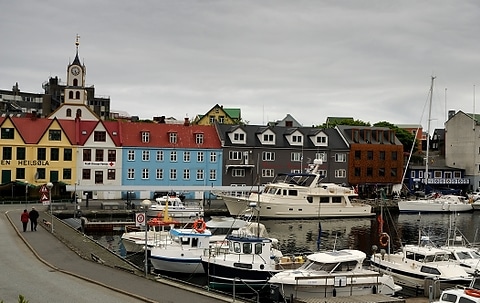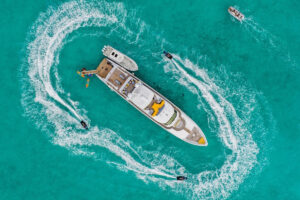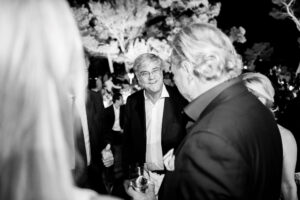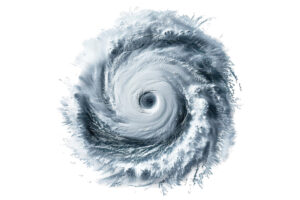
Passage to The Faroe Islands
Day 4-5
As we became more acquainted with the people of Stornoway and the small city’s ample facilities, it became harder to leave. Most impressive was the friendliness of the Port Authority’s staff. While Tony and I were browsing through the local chandlery, amused by the large assortment of heavy duty foul weather gear, rubber boots and oversized hardware, we met Iain Macleod, the Chairman of the Stornoway Port Authority, who invited us to share a fresh pot of afternoon coffee at his nearby office.
Iain and his assistant, Jane Maciver, eagerly showed us the Port’s future plans to expand its small marina to accommodate larger yachts such as Tony’s Fleming 65. Attracting more private yachts would, in their mind, contribute to the local economy. Like so many other municipalities throughout the Western world, money is tight, and it is faced with the proverbial “chicken or the egg” dilemma. They need to build the marina to attract yachts to generate revenue. But where do they find the funds to build the marina?
As we finished provisioning for our voyage to the Faroes (the island chain halfway between Scotland and Iceland) we were surprised to see so many young couples were grocery shopping together on this Friday afternoon. Among our most prized grocery purchases was a bottle of Jura “Superstition” single malt, produced on the island of Jura, where Tony’s great grandfather lived and became a well-known Scottish bard. If you’re a single malt drinker and you haven’t tried this rare sweet, smoky nectar, you’ve been missing one of the best.
After having dinner at a Thai restaurant, we returned to Venture II and prepared for our morning departure, checking the weather one more time. Once beyond the lee of Stornoway’s Lewis Island, we would be fully exposed to the North Atlantic for the 250 miles to the Faroes, and while the north winds were forecast to decrease from 25 to less than 10 knots by mid-day, the seas would remain in the 8 to 10-foot range for the better part of the day. Thankfully, the Fleming 65 has an inherently stable hull, which is also equipped with modern stabilizers.
We shoved off at 10 am on Saturday under gray skies with a light drizzle and a cool 40-degrees. Less than two hours into our passage and still in the lee of Lewis Island, Chris, Tony’s Captain, heard an alarm from the stabilizer control panel indicating a high hydraulic fluid temperature. He quickly discovered the saltwater cooling pump was hot to the touch, indicating a serious problem. We spotted a protected indentation in the coastline nearby and anchored to assess the situation. A burned out impeller was the culprit, undoubtedly caused by something being temporarily sucked into the raw water intake long enough to stop the flow and destroy the impeller.
Venture II is incredibly well equipped with spare parts, so it was hard to believe that the parts box marked “stabilizers” had everything but a spare impeller. This was no time to point fingers but instead a time to improvise. Two hours later, with the help of Steve D’Antonio, Chris had a spare hot water distribution pump jury-rigged, while Tony called his Fleming office in Southampton to arrange for spare impellers to be air shipped to Torshavn Harbour, our destination in the Faroes.
Underway again at 1430, we passed the tip of Lewis Island and headed out to the open sea, extremely thankful to Chris and Steve for fixing the stabilizers. While the seas weren’t much more than 6-feet at 8-second intervals, they were confused and on top of large ocean rollers. Our watch system of 2-hours on and 6-hours off was not demanding, and we soon got into that special rhythm of being offshore, where one’s daily routine is so dramatically different from life onshore.
Our voyage was uneventful, as the seas eventually decreased to three-feet and the winds to 10 knots or less. Running at 9 knots the Fleming is incredibly quiet, and with the stabilizers working, it is wonderfully comfortable. After 24-hours, we arrived in Torshavn Harbour, where we tied up to the visitor’s dock downtown. Within minutes we were met by a polite customs agent. He was soon followed by a visit from the harbormaster, who showed us a nearby spot where we could dock for a few days.
We soon grabbed our cameras and began a tour of the harbor area packed with a variety of small vessels rigged for fishing. Many were double-ended, wooden lapstrake boats in the 25 to 32-foot range with a small doghouse. Their sweeping sheer and curvaceous lines were both beautiful and practical, although I don’t think I would want to be out in the North Atlantic in one of these on anything other than a perfectly calm day.
Our plan is to use Torshavn as our base from which to explore many of the 18 islands in the Faroes archipelago by car, as most of the islands are connected by a series of roads and tunnels. Covering an area of 70 miles long by 75 miles wide roughly in the shape of an arrowhead, the islands have a population of slightly less than 50,000, with 19,000 being in the metro area of Torshavn, the capital.
The Faroes are roughly halfway between Scotland and Iceland at latitude 62º00 N, and although they sit in the path of the Gulf Stream, which prevents the harbours from ever freezing, summer weather is still quite cool, averaging in the low 40s to the 50s. It is a self-governing region of Denmark, although it is not part of the European Union. The Faroese language is derived from the Old Norse and is quite difficult to understand by English speaking people. Luckily many Faroese speak English.
Fishing is the main industry, although tourism is beginning to become more popular as the world’s over-fishing is taking its toll here. As the customs agent explained to us, “We now have cruise ships coming here, many filled with senior citizens from all over the world. After first seeing the rest of the world, they’re now discovering our world.”
We now plan to rent a car and discover as much of this world as we can in the next several days.
Stay tuned for more adventures.
For a gallery of images from George Sass, Sr.’s Iceland adventure click here.







